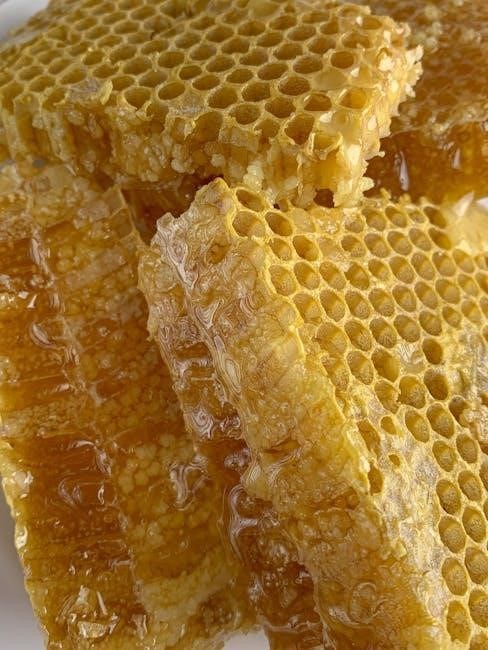Bikini waxing is a popular hair removal method offering a smooth, clean look. It removes hair from the bikini line, with options like Brazilian wax for fuller removal. Using hard or soft wax, it ensures long-lasting results, boosting confidence for any occasion.
1.1 What is a Bikini Wax?
A bikini wax is a hair removal technique that eliminates hair from the bikini line, providing a clean and groomed appearance. It’s a popular choice for those seeking a low-maintenance alternative to shaving or depilatory creams, offering smooth skin for weeks.
1.2 Benefits of Bikini Waxing
Bikini waxing offers multiple benefits, including long-lasting smooth skin, reduced hair regrowth, and a clean appearance. It minimizes ingrown hairs and irritation compared to shaving, boosting confidence for swimwear and intimate occasions. Regular waxing also leads to finer, softer hair over time, making maintenance easier and results more enduring.
1.3 Types of Bikini Waxes: Bikini Line vs. Brazilian Wax
Bikini waxing has two main types: the bikini line wax, which removes hair visible outside a swimsuit bottom, and the Brazilian wax, which removes all hair, including the labia and mons pubis. The Brazilian option offers a more thorough result, while the bikini line is ideal for those preferring less removal.

Preparing for a Bikini Wax
Proper preparation ensures a smooth waxing experience. Cleanse and exfoliate the area, avoid tight clothing, and ensure hair is the right length. This helps prevent irritation and ensures effective hair removal.
2.1 Skin Preparation: Cleansing and Exfoliating

Cleanse the bikini area with a gentle cleanser to remove dirt and oils. Exfoliate 24-48 hours before waxing to prevent ingrown hairs and ensure smooth wax application. Use a gentle scrub or exfoliating mitt to remove dead skin cells, promoting even hair removal and reducing irritation during the waxing process.

2.2 Hair Length Requirements for Effective Waxing
Hair should be 1/4 to 1/2 inches long for effective waxing. Too short, and the wax may not grip properly; too long, and it can cause discomfort. Trim excess hair before waxing to ensure smooth removal and minimize irritation. Proper hair length is key for a successful and pain-free experience.
2.3 Necessary Supplies for At-Home Bikini Wax
Essential supplies include hard or soft wax, a wax warmer or microwaveable wax, applicator sticks, wax strips, pre-wax oil, and post-wax lotion. Exfoliating gloves and soothing creams are optional. Protective sheeting or old towels can prevent mess. Ensure all items are ready for a smooth and hygienic waxing process at home.
The Bikini Waxing Process
Bikini waxing involves cleansing, applying wax, and removing hair in the opposite direction of growth. Proper technique ensures smooth results and minimizes discomfort;
3.1 Step-by-Step Guide to Applying the Wax
Applying wax requires precision. Start by cleansing the area and ensuring it’s dry. Heat the wax to the recommended temperature. Using a spatula, apply a thin layer in the direction of hair growth. Cover with a strip, press firmly, and pull quickly in the opposite direction for effective removal.
3.2 Proper Technique for Removing the Wax
Hold the skin taut with one hand to minimize irritation. Grip the wax strip firmly and pull quickly in the opposite direction of hair growth. Keep the strip close to the skin and avoid re-waxing the same area. Breathe deeply to relax, ensuring a clean and effective removal. Soothe the skin post-wax.
3.3 Tips for Minimizing Discomfort During Waxing
Take deep breaths to relax, ensuring the skin is held taut. Exfoliate beforehand to prevent ingrown hairs. Apply numbing cream 30 minutes prior. Use high-quality wax suited for sensitive areas. Avoid waxing during menstruation when skin is more sensitive. Soothe post-wax with aloe vera or chamomile to calm irritation.

Aftercare for Bikini Waxing
After waxing, soothe the skin with aloe vera or chamomile. Avoid tight clothing and exfoliate gently to prevent ingrown hairs. Maintain hygiene to promote healing and smooth results.
4;1 Soothing the Skin Post-Wax
After waxing, apply products with aloe vera or chamomile to calm irritation. Moisturizing helps hydrate sensitive areas, while avoiding tight clothing allows skin to breathe. Using gentle cleansers and avoiding harsh products for 24 hours ensures proper healing and reduces redness for a smoother recovery.
4.2 Preventing Ingrown Hairs and Irritation
Exfoliate regularly to prevent dead skin buildup, which can cause ingrown hairs. Use glycolic acid pads to keep pores clear and apply conditioning sprays or moisturizers to hydrate the skin. Avoid tight clothing and harsh products post-wax to reduce irritation and promote a smooth recovery.
4.3 Recommended Products for Post-Wax Care
Use soothing ingredients like aloe vera, chamomile, or lavender to calm the skin. Products such as Flamingo Mons Mist or Fur Ingrown Concentrate help hydrate and prevent irritation. Avoid tight clothing and opt for gentle, breathable fabrics to promote healing and maintain smooth results post-wax.

Common Mistakes to Avoid
Common mistakes include improper waxing technique, insufficient skin preparation, and over-waxing sensitive areas. These errors can lead to discomfort, irritation, or uneven results, so attention to detail is crucial.
5.1 Incorrect Waxing Technique
Incorrect waxing technique can lead to hair breakage, irritation, or ingrown hairs. Common errors include pulling the strip in the wrong direction, not holding skin taut, or re-waxing the same area. Proper technique involves applying wax in the direction of hair growth and removing it swiftly against the grain for effective results.
5.2 Insufficient Skin Preparation
Insufficient skin preparation can lead to uneven waxing results and increased irritation. Failing to cleanse and exfoliate the area properly can cause hair to break at the surface, resulting in patchy removal. Ensure skin is clean, dry, and free of lotions or oils before waxing for better adhesion and smoother results.
5.3 Over-Waxing Sensitive Areas
Over-waxing sensitive areas can cause irritation, redness, and ingrown hairs. Be gentle, especially around delicate zones, and avoid re-waxing the same spot multiple times. Follow a step-by-step guide and use high-quality waxing products to minimize discomfort and ensure a safe, effective process for sensitive skin.
Choosing the Right Wax for Your Skin
Selecting the right wax ensures effective hair removal and skin protection. Opt for hard wax for sensitive areas or soft wax for coarser hair, and look for soothing ingredients like beeswax for gentle, long-lasting results.
6.1 Hard Wax vs. Soft Wax: Which is Better?
Hard wax is ideal for sensitive areas, adhering only to hair, reducing irritation. Soft wax is better for larger areas and coarser hair, using strips for removal. Choose based on skin type and hair texture for optimal results and comfort during bikini waxing.
6.2 Waxing Kits for At-Home Use
At-home waxing kits provide everything needed for a smooth experience, including pre-prepped strips, wax, and soothing products. Kits like Nads Brazilian & Bikini Wax Kit or Flamingo’s offerings simplify the process, minimizing mess and ensuring professional-like results. They cater to sensitive skin and are widely available online or in beauty stores.
6.3 Ingredients to Look for in a Quality Wax
Quality wax should include soothing ingredients like beeswax, chamomile, and lavender oil to calm sensitive skin. Look for products with natural components that moisturize and protect, reducing irritation. Avoid harsh chemicals that can cause skin reactions, ensuring a gentle and effective waxing experience.
Managing Discomfort and Pain
Deep breathing and holding skin taut can reduce discomfort. Taking short breaks between sections allows skin to recover, making the process more manageable and less painful overall.
7.1 Breathing Techniques to Stay Calm
Deep breathing can significantly reduce anxiety during bikini waxing. Inhale deeply through your nose, hold for a few seconds, and exhale slowly through your mouth. This technique helps relax your body, making the process more comfortable and less stressful. Practice beforehand to stay calm and focused.
7.2 The Importance of Holding Skin Taut
Holding the skin taut during bikini waxing is crucial for reducing discomfort and ensuring effective hair removal. It helps prevent irritation and ingrown hairs by allowing the wax to adhere properly. Gently pull the skin tight in the opposite direction of hair growth for the best results and smoother skin.
7.3 When to Take Breaks During Waxing
Take breaks during waxing if discomfort becomes overwhelming or skin feels sensitive. If a spot requires multiple passes, allow the area to rest for 24 hours. This helps prevent irritation and ensures skin can recover, making the process more manageable and reducing the risk of prolonged discomfort.

How to Wax Specific Areas
Waxing specific areas like the bikini line, mons pubis, and labia majora requires precision. Each area has unique techniques for smooth results. Follow detailed steps for safe, effective waxing tailored to each region’s sensitivity and hair growth patterns.
8.1 Waxing the Bikini Line
Waxing the bikini line involves removing hair along the edges of your underwear line. Use a mirror for visibility, trim hair to 1/4 inch, and apply wax in the direction of growth. Hold skin taut, pull strips quickly, and soothe with post-wax products to minimize irritation and ensure smooth results.
8.2 Waxing the Mons Pubis
Waxing the Mons Pubis involves removing hair from the fatty tissue over the pubic bone. Clean the area, apply wax in the direction of hair growth, and pull strips quickly. Hold skin taut to minimize discomfort. Use post-wax products to soothe and hydrate, ensuring smooth results and preventing irritation.
8.3 Waxing the Labia Majora
Waxing the labia majora requires care and precision. Cleanse the area thoroughly, apply wax in the direction of hair growth, and pull strips firmly. To minimize discomfort, hold the skin taut and use soothing post-wax products. This ensures smooth results while maintaining the sensitive area’s health and hydration.
Comparing At-Home vs. Professional Waxing
At-home waxing offers convenience and cost savings, while professional waxing provides expertise and precision. DIY kits are easy to use but may lack salon-quality results. Professionals ensure better hygiene and smoother outcomes, making it worth the investment for many.
9.1 Pros and Cons of At-Home Bikini Wax
At-home bikini waxing offers convenience, cost savings, and privacy. However, it can be messy, painful, and requires skill; Results may vary, and improper techniques can cause irritation or ingrown hairs. Despite these challenges, many find it a practical alternative to salon visits for maintaining smooth skin.
9.2 When to Choose Professional Waxing Services
Professional waxing is ideal for precise results, especially for Brazilian or full bikini waxes. Experts ensure minimal discomfort, handle sensitive areas skillfully, and offer customized solutions. If you’re new to waxing, have sensitive skin, or prefer a stress-free experience, professional services provide better outcomes and reduce risks of irritation or uneven hair removal.
9.3 Cost Comparison: DIY vs. Salon
At-home bikini wax kits cost $10–$30, offering convenience and savings for regular use. Professional salons charge $30–$60 per session, varying by location and wax type. DIY kits are budget-friendly for long-term use, while salons provide expertise and a pampered experience, making them worth the investment for optimal results and convenience.

Troubleshooting Common Issues
10.1 Dealing with Uneven Results
Uneven results often occur due to missed hairs or improper waxing technique. Gently touch up with a clean razor or tweezers and exfoliate to prevent ingrown hairs for a smoother finish next time.
Uneven results after waxing can be due to missed hairs or improper technique. Use a clean razor or tweezers to remove stray hairs. Exfoliate gently to prevent ingrown hairs and ensure smoother results next time. For persistent issues, consider professional touch-ups or adjusting your waxing method for better coverage and precision.
10.2 Managing Redness and Irritation
Redness and irritation after bikini waxing are common. Apply soothing products like aloe vera or chamomile to calm the skin. Avoid tight clothing and hot showers for 24 hours. Use gentle cleansers and moisturizers to reduce inflammation. Exfoliate lightly to prevent ingrown hairs and promote healing for a smoother, irritation-free result.
10.3 How to Handle Missed Hairs
After waxing, missed hairs can be tackled by trimming them to the same length. Use a mirror for better visibility and gently remove stray hairs with tweezers or a small wax strip. Exfoliate lightly to prevent ingrown hairs, ensuring a smooth and even finish for optimal results.
Maintenance and Follow-Up
Regular waxing every 3-4 weeks maintains smooth skin. Exfoliate to prevent ingrown hairs and keep the area clean. Use products like glycolic pads and moisturizers for healthy skin and hydration.
11.1 How Often to Wax for Best Results
For optimal results, wax every 3–4 weeks when hair is 1/4–1/2 inches long. Consistency prevents hair from becoming too coarse, ensuring smoother removal. Regular waxing also reduces regrowth thickness over time, making future sessions easier and more effective.
11.2 Keeping the Area Hygienic Between Waxes
Maintaining cleanliness between waxes is essential. Use a gentle cleanser daily to remove bacteria and sweat. Moisturize to keep skin hydrated and prevent irritation. Exfoliate weekly to avoid dead skin buildup. Wear loose, breathable clothing to reduce friction and promote healing. This routine prevents ingrown hairs and keeps the area healthy.
11.3 Exfoliating to Prevent Ingrown Hairs
Exfoliating regularly helps prevent ingrown hairs by removing dead skin cells. Use a gentle scrub or exfoliating mitt 2-3 times weekly. Products with glycolic acid can also aid in keeping pores clear. For best results, exfoliate in circular motions and rinse thoroughly. This ensures smooth skin and reduces hair growth discomfort.

Additional Tips for a Smooth Experience
Use a mirror for better visibility, protect sensitive areas with wax strips, and stay relaxed. These steps enhance comfort and ensure a more effective waxing process.
12.1 The Role of Relaxation in Waxing Success
Relaxation is key to a successful bikini wax. Deep breathing helps calm nerves, reducing discomfort. A relaxed body allows for smoother wax application and removal. Staying composed minimizes anxiety, making the process more manageable and effective for achieving desired results.
12.2 Using Mirrors for Better Visibility
Using mirrors during bikini waxing ensures better visibility, helping you see all areas clearly. A handheld or full-length mirror allows precise application and removal, reducing missed spots. Clear visibility enhances accuracy, making the process more effective and ensuring a smooth, even result with less reapplication needed.
12.3 Protecting Sensitive Areas During Waxing
Protecting sensitive areas is crucial during waxing. Apply a thin layer of pre-wax oil to create a barrier, preventing the wax from adhering too aggressively. Hold skin taut to avoid irritation and use gentle, high-quality waxes formulated for sensitive skin. This ensures a safer, more comfortable experience with minimal risk of discomfort or injury.
Bikini waxing offers a smooth, confident grooming solution, whether done at home or professionally. Proper preparation, using quality products, and post-wax care are key to optimal results. Embrace the process, stay consistent, and enjoy the benefits of a hair-free, radiant appearance tailored to your personal preferences and lifestyle.
